Star Trek: Armada II Preview
We take a close look at Star Trek: Armada II, the latest real-time strategy game based on the popular series.
While the first Star Trek games often seemed to put a simulation of the show's setting above innovations in gameplay, the most recent games have taken a more independent tack and have even pushed the envelope of the Star Trek universe in new directions, adding new ships and technologies and fleshing out storylines. Star Trek: Armada II is a good example of how games in the franchise have been maturing. The game builds on the space-based real-time strategy gameplay of Star Trek: Armada, released last year, but greatly expands the size of the battles and takes better advantage of the 3D engine with a Homeworld-style tactical view.
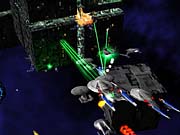
The Armada II single-player storyline is much more focused, spanning conflicts that let you command forces from the three most popular Star Trek races: the Federation, the Klingons, and the Borg. The Borg have developed a new ship that can assimilate an entire planet in a few moments, so the Federation fleet embarks on a mission to stop this new threat. However, in the meantime the Cardassians--under the influence of a Romulan scheme--take advantage of the Federation's weakness to strike in an all-out invasion, which can only be stopped by the intervening Klingons. In the culmination of a running Voyager plotline, the extra-dimensional species 8472 renews its attack on the Borg with the ultimate aim of eradicating life in the delta and alpha quadrants. Each of the three campaigns develops over the course of 10 missions, in contrast to the brief campaigns of the previous game. The voice work of Patrick Stewart and other actors from the television series carry along the story, starring in the roles of Jean-Luc Picard, General Martok, and the Borg Queen. The story seems remarkably engaging as an extension of the television franchises, and the events of the game take place shortly before those depicted in the Voyager finale.
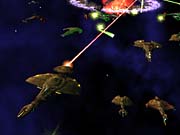
Armada II makes better use of the custom 3D engine developed for the first game. Since 3D graphics engines hit RTS gaming a couple of years back, many games with more mainstream appeal have maintained a locked, top-down camera, while tactical or more intricate games have had complicated, free-ranging cameras. While the original game fell into the former group, the new Star Trek game combines the two approaches by introducing a tactical view. In the new mode, the camera can rotate around any ship, and movement can go into the third dimension, up or down out of the plane of the map. You can toggle between the strategic and tactical views with a single key. This feature adds a tactical ship combat element reminiscent of Homeworld, but the game's maps are only a fraction as deep as they are wide and long, so general navigation and fleet maneuvers stay simple. Not only does the close-in view let advanced players fine-tune their fleet maneuvers, but it also affords a much more impressive view of the battles.
Graphics and Gameplay
Armada II is generally a much more visually pleasing game than its predecessor. The raw ship detail has been increased slightly (each ship has around 600 or 700 polygons), but there are often a lot more units on the screen at once. The preexisting ships have been retextured at higher detail levels, plus there are lots of new units, jumping the total from 35 to around 100 distinct models. There are now five 3D formations for moving grouped fleets of ships--one box formation and two offensive and two defensive ones tailored to each race--which tends to group the ships more interestingly and should make group combat maneuvers much easier to handle. Fleets can now group up to 16 ships, instead of eight, and you can expect to control up to 50 ships.
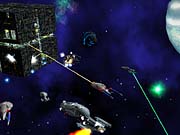
Given the predominance of beam weapons in Star Trek, Armada II battles start to look a bit like the ion frigate face-offs that were so distinctive in Homeworld. In case you can't get enough eye-candy in the heat of action or just want to study strategies more closely, there's the option to take movies of missions and multiplayer matches to replay later. The replays are stored in a small file to make it convenient to trade online, much in the fashion of the Myth games.
In addition to the extra tactical nuance, there are a number of enhancements to the strategic gameplay. Perhaps the most dramatic change is that ships can now enter warp to rapidly move around the map, and to compensate for faster fleet movement, the maps are about twice as large. Naturally, there are some limitations to this capability, as ships cannot fire while engaged in warp travel and their sensor range is sharply reduced. To prevent repetitive hit-and-run attacks, the ship AI is set to follow attackers that engage then flee at warp speeds, and it's not possible to warp while close to the gravity well of a planet. More generally, the unit AI has been enhanced for additional autonomy and now lets you select not only different levels of aggression for movement but also for firing special weapons. While the first game required you to manually trigger special weapons, the computer can now be set to three levels of independent firing, from automatically using all of the special weapons power to using only a portion or leaving it up to your manual discretion.
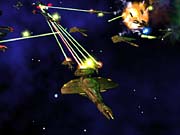
The game's resource model has also seen a few tweaks. Considering that the premise for the game is that the Borg have a new planet assimilation weapon, it's suitable for planets to play a bigger strategic role in actual gameplay. Crew, a resource required for all ship building, is now derived from colonizing planets, instead of just slowly replenishing from an abstract source outside the map. The standard humanoid races must build colony ships to settle new planets, which progressively become better sources of crew. The Borg try to assimilate entire planets already ripe for the picking, and assimilated populations must be removed before humanoid resettlement. Species 8472 have no use for planets and destroy them. There is also a new resource: latinum, the precious metal prized by Ferengi traders. It's now possible to build a trading station, where you can buy and sell the two primary resources, ore and gas, to better balance out your stockpiles.
New Ships
In the original Armada, same-sized ships were closely balanced from one side to another--perhaps too closely. Those who are used to seeing Borg cubes dwarf Federation ships on the shows will be a bit surprised to see how small cubes look in Armada. The television show used just one miniature model for all Borg cubes, so the game's developer has improvised a bit and created the larger tactical cube. But perhaps Armada II's most impressive change is that eight standard or tactical cubes can now merge into a fusion cube, which is utterly terrifying in size and power. It's very satisfying to see a mass of ships trying to stop a single fusion cube, succumbing one by one to the green Borg beam that sliced up an entire Federation fleet at Wolf 359. As you'd expect, the fusion cube--particularly the fusion tactical cube--is a very expensive late game unit.
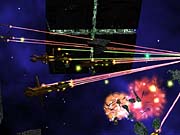
Not only are there much larger ships but also more smaller ships. Armada II introduces frigate vessels for each race that play a support role. For instance, Federation frigates can reinitialize the shield matrix for ships in combat and Romulan frigates can be used to allow Romulan warbirds to fire while cloaked. All ship types also now have a unique special weapon or ability. In some cases, groups of ships combine to act together, such as the sleek species 8472 cruisers that fire a magnified attack from a radial formation. In general, Armada II doesn't rely on ships of a given class to be similar to create balance. The developer has instead looked to balance the sides as a whole, which means the 60 or so new ships in the game add a lot of diversity. Most notably, the Klingons don't rely so much on cloaking as they did in the first game (making them resemble the Romulans) but instead pack a powerful offensive punch at the expense of shielding.
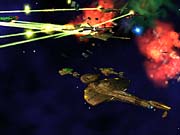
At this point, Star Trek: Armada II looks to be a strong step beyond its solid yet conventional predecessor. The members of the development team at Mad Doc seem to be big fans of the Star Trek universe and have built something that brings together many recent developments in the storyline. There are even some touches from other Star Trek games, like the Federation mimic ship, the Incursion, which was introduced in Star Trek Away Team. The game is looking very complete. It's several weeks past its alpha milestone, which means that all the art and assets are in the game and that features will soon be locked down. To be sure there are a number of finishing touches that remain. These may include GeForce3 vertex effects, such as making parts of species 8472 ships--and the fluidic space of the aliens' native dimension--undulate in an organic manner. It will be interesting to see how all of the innovations balance out when it ships this November.
Got a news tip or want to contact us directly? Email news@gamespot.com
Join the conversation